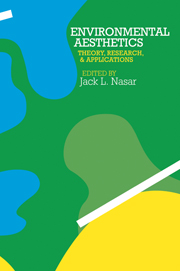Book contents
- Frontmatter
- Contents
- List of figures
- List of tables
- List of contributors and participants
- Acknowledgments
- Preface
- Section I Theory
- Section II Empirical studies
- Section III Applications
- Editor's introduction
- 27 Visual needs in urban environments and physical planning
- 28 A survey of aesthetic controls in English speaking countries
- 29 Scenic-beauty issues in public policy making
- 30 Coping with aesthetics and community design in rural communities
- 31 Toward theory generation in landscape aesthetics
- 32 Aesthetic regulation and the courts
- References
- Index of authors
- Subject index
27 - Visual needs in urban environments and physical planning
Published online by Cambridge University Press: 05 September 2013
- Frontmatter
- Contents
- List of figures
- List of tables
- List of contributors and participants
- Acknowledgments
- Preface
- Section I Theory
- Section II Empirical studies
- Section III Applications
- Editor's introduction
- 27 Visual needs in urban environments and physical planning
- 28 A survey of aesthetic controls in English speaking countries
- 29 Scenic-beauty issues in public policy making
- 30 Coping with aesthetics and community design in rural communities
- 31 Toward theory generation in landscape aesthetics
- 32 Aesthetic regulation and the courts
- References
- Index of authors
- Subject index
Summary
Introduction
The clarification of and agreement on visual objectives and their design implementation are, without doubt, among the weakest stages of the planning process. This design shortcoming is reflected in the product itself; few of the large-scale projects built in the last decades are able to evoke satisfactory aesthetic responses from the lay public or the critics, and it is possible to advance the hypothesis that this visual dissatisfaction is part of a major conflict between people and the new built environment. In contrast to the negative feelings evoked by contemporary urban design, there is widespread consensus on the positive visual qualities of many urban creations of the past, suggesting that the present inability to deal with the aesthetic issues must be traced either to major changes in the nature of cities or to major changes in the process of planning and design- and most likely to both factors.
Although the methodology to introduce visual inputs in the design process is poor and inadequate, the visual qualities of the built environment are extremely important. There is still a debate among social scientists on whether the environment bears important effects on humans and society, and it is possible to find researchers taking a whole range of different positions. Among the skeptics are key writers, such as Webber (1967), who emphasized the importance of nongeographical space in human relations, and Gans (1968), who stressed the importance of social systems, as against the built environment.
- Type
- Chapter
- Information
- Environmental AestheticsTheory, Research, and Application, pp. 395 - 421Publisher: Cambridge University PressPrint publication year: 1988
- 5
- Cited by



